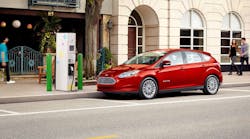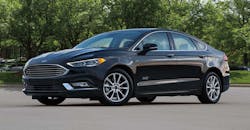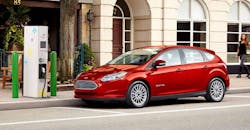Download this article as a .PDF
Electricity may one day rule the world’s vehicles rather than gasoline. As fossil fuels become more expensive, and the technologies and manufacturing costs associated with electric vehicles (EVs) and hybrid electric vehicles (HEVs)—which combine electric and gas-powered engines—become more affordable, the prices for EVs and HEVs will drop, making such vehicles more widespread on the roads.
When drivers take the wheel of their new EV or HEV for the first time, they will also find that the drive system is not the only one powered by electricity. Rather, RF/microwave signals throughout each vehicle and beyond it are helping with the day’s drive. That comforting invite to “leave the driving to us” may very well refer to those RF/microwave systems.
The disadvantages of EVs and HEVs compared to gasoline or powered vehicles have included the aforementioned relatively high costs, limited driving ranges (typically as much as 250 miles compared to a vehicle that can be refueled at any convenient gas station), and long recharge times required to bring a battery to full charge once it has been depleted of energy. But some companies, including Qualcomm, are exploring ways to recharge the batteries of EVs and HEVs while they are moving, without having to make long stops at recharging stations.
Both EVs (Fig. 1) and HEVs (Fig. 2) are growing in numbers worldwide—approaching or exceeding the number of fossil-fuel-powered vehicles in some places. For example, according to the Reuters news agency, more than half of all new car sales in Norway are EVs as of 2017, rather than vehicles with gasoline-powered internal combustion engines. Drivers are highly incentivized to own and drive electric vehicles in Norway since that country’s government offers significant tax exemptions with the purchase and ownership of an EV.
1. The 2018 Ford Fusion Energi plug-in hybrid has an electric motor with a high-voltage battery and a gasoline engine. Its estimated driving range is 21 miles. Braking the car provides more power: It uses kinetic braking energy captured from its Regenerative Braking System to capture and store energy in its battery for later use. (Courtesy of Ford Motor Company)
A typical EV or HEV represents an impressive interconnection of electrical and mechanical subsystems that must communicate with each other as a form of miniature internet. These many subsystems in turn are designed to communicate with the outside world via the internet and numerous on-board sensors and communications links. Wireless communications from a modern vehicle of any kind—including gas powered—can take place in a number of different ways, including vehicle to vehicle (V2V), vehicle to infrastructure (V2I), and vehicle to the cloud or Internet (V2C). There may also be communications from vehicle to pedestrian (V2P) and vehicle to everything (V2X).
Maintaining a Charge
Perhaps more important than inclusion of positioning systems, such as GPS or wireless communications systems in EVs or HEVs, is the integration of some means to provide long-term voltage-charging solutions. Such a subsystem will help improve the energy efficiency of each vehicle and perhaps reduce the “range anxiety” that is associated with EVs and HEVs—of having them run out of battery charge before reaching a destination.
A traditional solution exists, where available, in the form of a charging station and a long stop required to recharge an electric vehicle’s battery at a charging station. A newer, more innovative, solution is in the form of a technology known as wireless power transfer (WPT), as proposed by Qualcomm and others.
Rather than using connected wires and conduction to charge an electric vehicle’s depleted battery, WPT employs induction, in which electric power is transferred over an air gap. Inductive charging is less efficient than conductive charging. But it is very convenient for a user, with no mating of plugs, and is capable of high power charging levels.
In a WPT system, a transmitter coil transfers current from an input power source to a magnetic field. A receive coil transforms the magnetic field into power that can be stored in the rechargeable battery of an EV or HEV. WPT battery charging techniques can be used on EVs and HEVs whether they are stationary or in motion, depending upon how the WPT system is configured.
In the Qualcomm dynamic charging approach, the batteries of an EV or HEV can be recharged by means of inductive charging, as the vehicle is driving over roadways in which specially engineered charging pads have been embedded into the road’s surface. It is a variation of the Qualcomm Halo wireless electric vehicle charging (WEVC) approach in which the charging pads are embedded into the road surfaces of parking spaces, so that an EV’s battery can be recharged while it is stationary and parked for some time.
The Energy Dynamics Lab (EDL) of the Utah State University Research Foundation has explored the potential of inductive charging methods for EVs and HEVs in both stationary and vehicles in motion. The organization’s current stationary inductive charging systems are designed for charging at 5-kW power levels and wireless charging frequency of 20 kHz; their systems are capable of operating at charging frequencies extending from 20 to 100 kHz.
For an air gap of 6.0 to 10.5 in. between magnetic transmit and receive antennas, current systems provide an output voltage to +300 V dc with better than 90% efficiency, although higher efficiency levels are possible. By developing systems with wider inductive air gaps, higher voltage charging levels will be possible, to as much as +1200 V dc.
In term of in-motion IPT, a section of Interstate 5 through Seattle is often cited as an example of an “electrified” portion of roadway that has been equipped for in-motion power transfer, with costs that are quite competitive to those required for ICE vehicles. Still, the costs of electrifying modern highways such as this for in motion charging of EVs and/or HEVs approaches $3 million per lane per mile, with many goals set on lowering that cost over time to $2 million or less per lane per mile. This experimental system integrated into a lane of I-5 provides 40 kW charging power at a vehicle speed of 75 mph, with more than 90% transfer efficiency.
2. The 2018 Ford Focus Electric vehicle is all electric, powered by a 35-kWh liquid-cooled, lithium-ion battery (and shown here next to a recharging station). It also uses regenerative braking to capture energy during braking and store it in the battery for later use. It features a 107-kW electric motor and a 1-speed automatic transmission. (Courtesy of Ford Motor Company)
Connecting Electric Cars
Of course, transferring energy from stations to vehicles is just one example of the massive amount of wired and wireless communications that will be taking place within and without EVs and HEVs. Within each vehicle is the equivalent of a miniature internet, with many electronic systems linked via multiple high-speed microprocessors to an advanced driver assistance system (ADAS) that is projected to be a key part of the autonomous vehicle of the future.
The ADAS for each vehicle will in turn be treated as an Internet of Things (IoT) device over the real Internet, allowing those with the proper credentials to track the location of a connected vehicle via internet access, even the amount of electricity left in a vehicle’s battery before its next charge.
SAE International has established standards for EV and HEV terminology, including methods for conductive and inductive charge coupling and various approaches for testing fully integrated EV and HEV systems. The organization has also established a number of different levels of ADAS use on the road to the “driverless car.” In SAE Level 0, there is no use of ADAS technology, and the driver operates all controls.
In SAE Level 1, the ADAS is available to assist a human driver with braking and accelerating. In SAE Level 2, the ADAS can control steering and braking and accelerating under some circumstances, but the human driver must be monitoring the roadway and perform the majority of the driving. In SAE Level 3, the ADAS does a bit more of the driving than the human driver, while in SAE Level 4, under some circumstances, the ADAS has full control of the vehicle. In SAE Level 5, the human passengers are essentially along for the ride.
Both EVs and HEVs will rely on RF/microwave technologies for charging and for wireless communications links to the internet as these vehicles are increasingly used on modern highways. In addition to such techniques as inductive charging, a great deal of research is being performed on different forms of lithium-ion batteries and solid-state batteries that are light in weight—but capable of storing the amount of power needed for an EV or HEV—and with the capabilities to survive numerous recharge cycles and to maintain required charge levels when operating within the wide ranges of environmental conditions in which an EV and HEV may be used.
At present, the costs of EVs and HEVs are high relative to those of conventional internal-combustion vehicles, although those costs will drop as EVs and HEVs are mass-produced in larger numbers and as advances are made in the batteries used to store charge within those EVs and HEVs. The increasing number of EVs and HEVs appearing as IoT devices on the internet will literally drive the need for the additional wireless bandwidth provided by 5G wireless networks. The growing use of EVs and HEVs will contribute to a growing demand for 5G wireless communications as a result, with drivers and driverless users having wireless connections at any one time.



